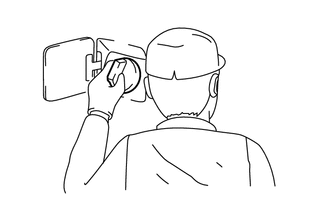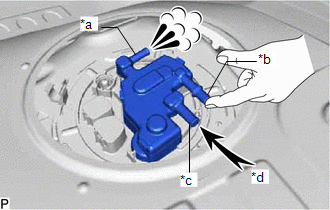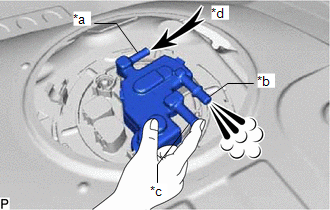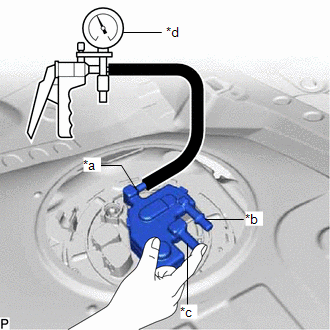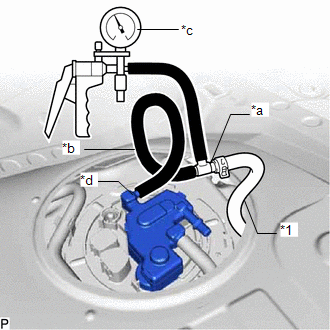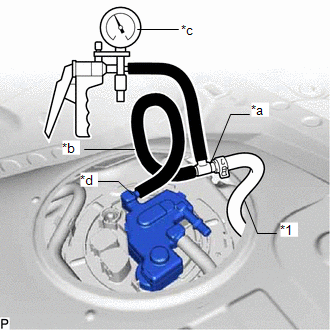Toyota Yaris: Canister / On-vehicle Inspection
ON-VEHICLE INSPECTION
PROCEDURE
1. INSPECT CANISTER (FUEL SUCTION PLATE SUB-ASSEMBLY) (for Fuel Tank Cap Method)
(a) Inspect evaporative emission control system.
Click here

(b) Check for clogs in the air filter (when not using the GTS).
(1) Start the engine.
(2) Warm up the engine.
(3) Allow the engine to idle for 15 minutes.
(4) Open the fuel tank cap assembly to discharge the pressure in the fuel tank assembly.
(5) Close the fuel tank cap assembly and allow the engine to idle for 30 seconds.
| (6) Open the fuel tank cap assembly and check for inhalation sounds. OK: No whooshing sounds (inhalation sound) are heard. HINT: If there is a smell of gasoline and a whooshing sound (exhalation sound) is heard, positive pressure in the fuel tank assembly is being discharged. This is not a malfunction. |
|
(c) Check for clogs in the air filter (when using the GTS).
(1) Connect the GTS to the DLC3.
(2) Start the engine.
(3) Turn the GTS on.
(4) Enter the following menus: Powertrain / Engine / Active Test / Activate the EVAP Purge VSV.
Powertrain > Engine > Active Test| Tester Display |
|---|
| Activate the EVAP Purge VSV |
(5) Open the fuel tank cap assembly to discharge the pressure in the fuel tank assembly.
(6) Perform the Active Test "Activate the EVAP Purge VSV" while the engine is idling.
(7) Close the fuel tank cap assembly and allow the engine to idle for 30 seconds.
(8) Open the fuel tank cap assembly and check for inhalation sounds.
OK:
No whooshing sounds (inhalation sound) are heard.
HINT:
If there is a smell of gasoline and a whooshing sound (exhalation sound) is heard, positive pressure in the fuel tank assembly is being discharged. This is not a malfunction.
2. INSPECT CANISTER (FUEL SUCTION PLATE SUB-ASSEMBLY) (for Vacuum Measurement Method)
(a) Visually check the canister (fuel suction with pump and gauge tube assembly) for airtightness.
(1) Visually check the canister (fuel suction with pump and gauge tube assembly) for cracks or damage, and check that there is no smell of gasoline.
(b) Inspect the airflow of the canister (fuel suction with pump and gauge tube assembly).
NOTICE:
When inspecting with parts installed on the vehicle, be sure to remove the fuel tank cap assembly.
| (1) Close the port (B) and check that air flows from the port (A) when air is blown into the port (C). OK: The air flows from the port (A). |
|
(c) Inspect the check valve.
NOTICE:
When inspecting with parts installed on the vehicle, be sure to remove the fuel tank cap assembly.
| (1) Close the port (C) and check that air flows from the port (B) when air is blown into the port (A). OK: The air flows from the port (B). |
|
| (2) Using a vacuum pump, apply vacuum to the port (A) with the port (C) closed and check that air flows into the port (B). OK: The vacuum is maintained at first. By gradually increasing the vacuum, air flows and the vacuum decreases after the vacuum reaches a certain level. |
|
| (d) Check for clogs in the air filter (when not using the GTS). (1) Connect the No. 1 fuel evaporation tube sub-assembly to the canister (fuel suction with pump and gauge tube assembly) via the 3-way connector, hose and vacuum pump as shown in the illustration. (2) Start the engine. (3) Warm up the engine. (4) Allow the engine to idle for 15 minutes. (5) Check the needle of the vacuum pump. OK: The needle of the vacuum pump does not rise from its initial position. HINT: The needle may shake due to engine vibration, etc., but if it immediately returns to its initial position, there is no problem. |
|
| (e) Check for clogs in the air filter (when using the GTS). (1) Connect the No. 1 fuel evaporation tube sub-assembly to the canister (fuel suction with pump and gauge tube assembly) via the 3-way connector, hose and vacuum pump as shown in the illustration. (2) Connect the GTS to the DLC3. (3) Start the engine. (4) Turn the GTS on. (5) Enter the following menus: Powertrain / Engine / Active Test / Activate the EVAP Purge VSV. Powertrain > Engine > Active Test
(6) Perform the Active Test "Activate the EVAP Purge VSV" while the engine is idling. (7) Check the needle of the vacuum pump. OK: The needle of the vacuum pump does not rise from its initial position. HINT: The needle may shake due to engine vibration, etc., but if it immediately returns to its initial position, there is no problem. |
|
 Components
Components
COMPONENTS ILLUSTRATION
*1 FUEL PUMP *2 FUEL SUCTION WITH PUMP AND GAUGE TUBE ASSEMBLY *3 FUEL SENDER GAUGE ASSEMBLY *4 CANISTER (FUEL SUCTION WITH PUMP AND GAUGE TUBE ASSEMBLY) *5 FUEL MAIN VALVE ASSEMBLY *6 NO...
 Removal
Removal
REMOVAL CAUTION / NOTICE / HINT The necessary procedures (adjustment, calibration, initialization or registration) that must be performed after parts are removed and installed, or replaced during canister (fuel suction plate sub-assembly) removal/installation are shown below...
Other information:
Toyota Yaris XP210 (2020-2026) Owner's Manual: Gear Shift Indicator
The gear shift indicator supports you to obtain optimum fuel economy and smooth driving. It displays the selected gear position in the combination meter as well as notifies the driver to change to the most suitable gear position corresponding to the actual driving condition...
Toyota Yaris XP210 (2020-2026) Owner's Manual: Inspecting Engine Oil Level
Be sure the vehicle is on a level surface. Warm up the engine to normal operating temperature. Turn it off and wait at least 5 minutes for the oil to return to the oil pan. Pull out the dipstick, wipe it clean, and reinsert it fully. Full OK Low Pull it out again and examine the level...
Categories
- Manuals Home
- Toyota Yaris Owners Manual
- Toyota Yaris Service Manual
- Brake System Control Module "A" System Voltage System Voltage Low (C137BA2)
- Immobilizer System
- How to connect USB port/Auxiliary jack
- New on site
- Most important about car
Key Suspend Function
If a key is left in the vehicle, the functions of the key left in the vehicle are temporarily suspended to prevent theft of the vehicle.
To restore the functions, press the unlock button on the functions-suspended key in the vehicle.

